Input interpretation

CrO_3 chromium trioxide + MnO manganese monoxide ⟶ MnO_2 manganese dioxide + Cr_2O_3 chromium(III) oxide
Balanced equation
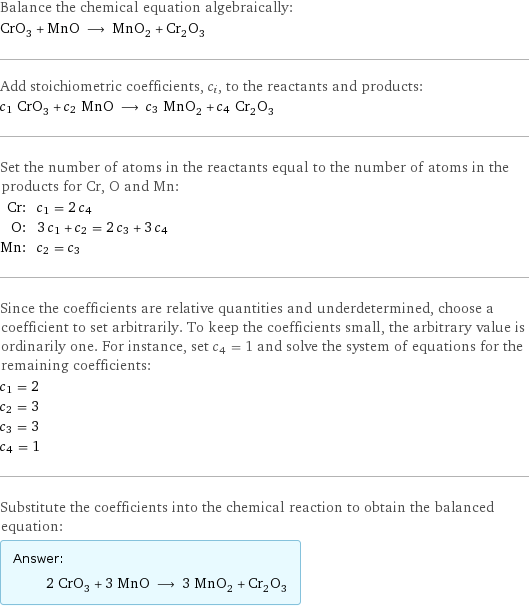
Balance the chemical equation algebraically: CrO_3 + MnO ⟶ MnO_2 + Cr_2O_3 Add stoichiometric coefficients, c_i, to the reactants and products: c_1 CrO_3 + c_2 MnO ⟶ c_3 MnO_2 + c_4 Cr_2O_3 Set the number of atoms in the reactants equal to the number of atoms in the products for Cr, O and Mn: Cr: | c_1 = 2 c_4 O: | 3 c_1 + c_2 = 2 c_3 + 3 c_4 Mn: | c_2 = c_3 Since the coefficients are relative quantities and underdetermined, choose a coefficient to set arbitrarily. To keep the coefficients small, the arbitrary value is ordinarily one. For instance, set c_4 = 1 and solve the system of equations for the remaining coefficients: c_1 = 2 c_2 = 3 c_3 = 3 c_4 = 1 Substitute the coefficients into the chemical reaction to obtain the balanced equation: Answer: | | 2 CrO_3 + 3 MnO ⟶ 3 MnO_2 + Cr_2O_3
Structures

+ ⟶ +
Names

chromium trioxide + manganese monoxide ⟶ manganese dioxide + chromium(III) oxide
Reaction thermodynamics
Gibbs free energy
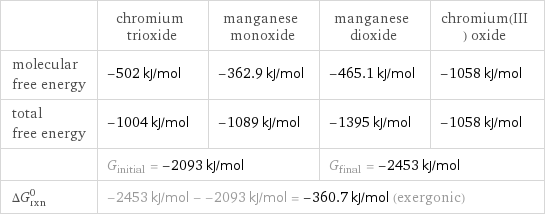
| chromium trioxide | manganese monoxide | manganese dioxide | chromium(III) oxide molecular free energy | -502 kJ/mol | -362.9 kJ/mol | -465.1 kJ/mol | -1058 kJ/mol total free energy | -1004 kJ/mol | -1089 kJ/mol | -1395 kJ/mol | -1058 kJ/mol | G_initial = -2093 kJ/mol | | G_final = -2453 kJ/mol | ΔG_rxn^0 | -2453 kJ/mol - -2093 kJ/mol = -360.7 kJ/mol (exergonic) | | |
Entropy
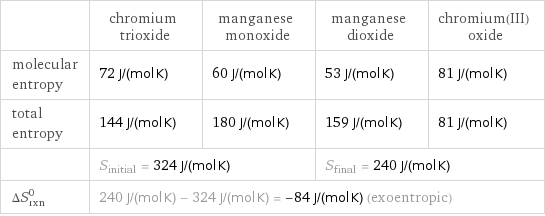
| chromium trioxide | manganese monoxide | manganese dioxide | chromium(III) oxide molecular entropy | 72 J/(mol K) | 60 J/(mol K) | 53 J/(mol K) | 81 J/(mol K) total entropy | 144 J/(mol K) | 180 J/(mol K) | 159 J/(mol K) | 81 J/(mol K) | S_initial = 324 J/(mol K) | | S_final = 240 J/(mol K) | ΔS_rxn^0 | 240 J/(mol K) - 324 J/(mol K) = -84 J/(mol K) (exoentropic) | | |
Equilibrium constant
![Construct the equilibrium constant, K, expression for: CrO_3 + MnO ⟶ MnO_2 + Cr_2O_3 Plan: • Balance the chemical equation. • Determine the stoichiometric numbers. • Assemble the activity expression for each chemical species. • Use the activity expressions to build the equilibrium constant expression. Write the balanced chemical equation: 2 CrO_3 + 3 MnO ⟶ 3 MnO_2 + Cr_2O_3 Assign stoichiometric numbers, ν_i, using the stoichiometric coefficients, c_i, from the balanced chemical equation in the following manner: ν_i = -c_i for reactants and ν_i = c_i for products: chemical species | c_i | ν_i CrO_3 | 2 | -2 MnO | 3 | -3 MnO_2 | 3 | 3 Cr_2O_3 | 1 | 1 Assemble the activity expressions accounting for the state of matter and ν_i: chemical species | c_i | ν_i | activity expression CrO_3 | 2 | -2 | ([CrO3])^(-2) MnO | 3 | -3 | ([MnO])^(-3) MnO_2 | 3 | 3 | ([MnO2])^3 Cr_2O_3 | 1 | 1 | [Cr2O3] The equilibrium constant symbol in the concentration basis is: K_c Mulitply the activity expressions to arrive at the K_c expression: Answer: | | K_c = ([CrO3])^(-2) ([MnO])^(-3) ([MnO2])^3 [Cr2O3] = (([MnO2])^3 [Cr2O3])/(([CrO3])^2 ([MnO])^3)](../image_source/29827c963b5c315bca413e53c636fc97.png)
Construct the equilibrium constant, K, expression for: CrO_3 + MnO ⟶ MnO_2 + Cr_2O_3 Plan: • Balance the chemical equation. • Determine the stoichiometric numbers. • Assemble the activity expression for each chemical species. • Use the activity expressions to build the equilibrium constant expression. Write the balanced chemical equation: 2 CrO_3 + 3 MnO ⟶ 3 MnO_2 + Cr_2O_3 Assign stoichiometric numbers, ν_i, using the stoichiometric coefficients, c_i, from the balanced chemical equation in the following manner: ν_i = -c_i for reactants and ν_i = c_i for products: chemical species | c_i | ν_i CrO_3 | 2 | -2 MnO | 3 | -3 MnO_2 | 3 | 3 Cr_2O_3 | 1 | 1 Assemble the activity expressions accounting for the state of matter and ν_i: chemical species | c_i | ν_i | activity expression CrO_3 | 2 | -2 | ([CrO3])^(-2) MnO | 3 | -3 | ([MnO])^(-3) MnO_2 | 3 | 3 | ([MnO2])^3 Cr_2O_3 | 1 | 1 | [Cr2O3] The equilibrium constant symbol in the concentration basis is: K_c Mulitply the activity expressions to arrive at the K_c expression: Answer: | | K_c = ([CrO3])^(-2) ([MnO])^(-3) ([MnO2])^3 [Cr2O3] = (([MnO2])^3 [Cr2O3])/(([CrO3])^2 ([MnO])^3)
Rate of reaction
![Construct the rate of reaction expression for: CrO_3 + MnO ⟶ MnO_2 + Cr_2O_3 Plan: • Balance the chemical equation. • Determine the stoichiometric numbers. • Assemble the rate term for each chemical species. • Write the rate of reaction expression. Write the balanced chemical equation: 2 CrO_3 + 3 MnO ⟶ 3 MnO_2 + Cr_2O_3 Assign stoichiometric numbers, ν_i, using the stoichiometric coefficients, c_i, from the balanced chemical equation in the following manner: ν_i = -c_i for reactants and ν_i = c_i for products: chemical species | c_i | ν_i CrO_3 | 2 | -2 MnO | 3 | -3 MnO_2 | 3 | 3 Cr_2O_3 | 1 | 1 The rate term for each chemical species, B_i, is 1/ν_i(Δ[B_i])/(Δt) where [B_i] is the amount concentration and t is time: chemical species | c_i | ν_i | rate term CrO_3 | 2 | -2 | -1/2 (Δ[CrO3])/(Δt) MnO | 3 | -3 | -1/3 (Δ[MnO])/(Δt) MnO_2 | 3 | 3 | 1/3 (Δ[MnO2])/(Δt) Cr_2O_3 | 1 | 1 | (Δ[Cr2O3])/(Δt) (for infinitesimal rate of change, replace Δ with d) Set the rate terms equal to each other to arrive at the rate expression: Answer: | | rate = -1/2 (Δ[CrO3])/(Δt) = -1/3 (Δ[MnO])/(Δt) = 1/3 (Δ[MnO2])/(Δt) = (Δ[Cr2O3])/(Δt) (assuming constant volume and no accumulation of intermediates or side products)](../image_source/a816036900d7ad1ad29633a049bb4ffa.png)
Construct the rate of reaction expression for: CrO_3 + MnO ⟶ MnO_2 + Cr_2O_3 Plan: • Balance the chemical equation. • Determine the stoichiometric numbers. • Assemble the rate term for each chemical species. • Write the rate of reaction expression. Write the balanced chemical equation: 2 CrO_3 + 3 MnO ⟶ 3 MnO_2 + Cr_2O_3 Assign stoichiometric numbers, ν_i, using the stoichiometric coefficients, c_i, from the balanced chemical equation in the following manner: ν_i = -c_i for reactants and ν_i = c_i for products: chemical species | c_i | ν_i CrO_3 | 2 | -2 MnO | 3 | -3 MnO_2 | 3 | 3 Cr_2O_3 | 1 | 1 The rate term for each chemical species, B_i, is 1/ν_i(Δ[B_i])/(Δt) where [B_i] is the amount concentration and t is time: chemical species | c_i | ν_i | rate term CrO_3 | 2 | -2 | -1/2 (Δ[CrO3])/(Δt) MnO | 3 | -3 | -1/3 (Δ[MnO])/(Δt) MnO_2 | 3 | 3 | 1/3 (Δ[MnO2])/(Δt) Cr_2O_3 | 1 | 1 | (Δ[Cr2O3])/(Δt) (for infinitesimal rate of change, replace Δ with d) Set the rate terms equal to each other to arrive at the rate expression: Answer: | | rate = -1/2 (Δ[CrO3])/(Δt) = -1/3 (Δ[MnO])/(Δt) = 1/3 (Δ[MnO2])/(Δt) = (Δ[Cr2O3])/(Δt) (assuming constant volume and no accumulation of intermediates or side products)
Chemical names and formulas
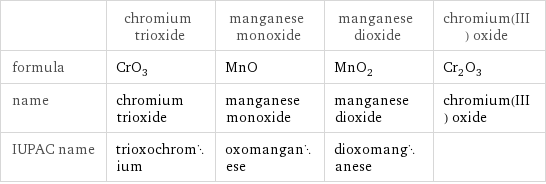
| chromium trioxide | manganese monoxide | manganese dioxide | chromium(III) oxide formula | CrO_3 | MnO | MnO_2 | Cr_2O_3 name | chromium trioxide | manganese monoxide | manganese dioxide | chromium(III) oxide IUPAC name | trioxochromium | oxomanganese | dioxomanganese |
Substance properties
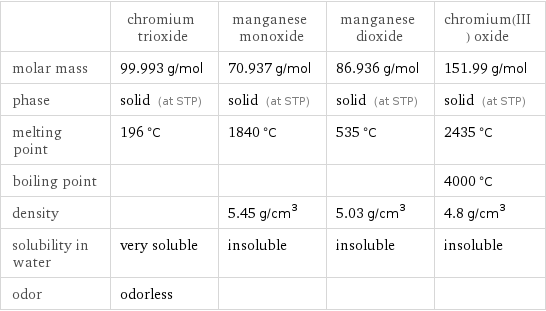
| chromium trioxide | manganese monoxide | manganese dioxide | chromium(III) oxide molar mass | 99.993 g/mol | 70.937 g/mol | 86.936 g/mol | 151.99 g/mol phase | solid (at STP) | solid (at STP) | solid (at STP) | solid (at STP) melting point | 196 °C | 1840 °C | 535 °C | 2435 °C boiling point | | | | 4000 °C density | | 5.45 g/cm^3 | 5.03 g/cm^3 | 4.8 g/cm^3 solubility in water | very soluble | insoluble | insoluble | insoluble odor | odorless | | |
Units
